
 |
||||||||||||||
 |
||||||||||||||
|
DDT graciously offered to do Ruby Muhammed and I suggested he have fun with it. He certainly did! * * * Ruby Muhammad, or Ruby Pittman, aged either 103 or 113 and who wasn't ever Ellijah's widow was, to be kind, a rather enigmatic character or, to be unkind, an absolute fucking nobody. She wasn't widely known, possibly because she did nothing exceptional of note during her exceptionally long life. There is little information about her on the web, and a good proportion of what is there is inaccurate. There were "misunderstandings" about her age and her marital history. Online biographies of her are beset with inexactitude, variously purporting her to be ten years older than she probably was, or erroneously maintaining that she was indeed married to the founder of the Nation of Islam. Her tenuous claim to fame is that she was once described by Louis Farrakhan as "The Mother of Islam." This seems to have caused her to become some sort of tutelary deity for elderly African-American Muslim ladies. But that's it. She didn't make any great speeches, she never held any sort of political or religious office, never refused to give up her seat on a bus, never went to jail for justice, never immolated herself in a public square, never went on hunger strike, etc. She was just ... there. And old. But not nearly as old as she said she was. No doubt Ruby Muhammad lived a virtuous life of blameless domesticity and will be sadly missed by those who were close to her, now that she is closer to Allah. She had a website, but no one has bothered to update it to tell us that she is now dead, and its sole purpose seems to be as a vehicle for her eldest daughter to sell bean pie to the masses. Words fail me. So there you have it. There is nothing else to say, apart from that she died of lung cancer. No major media sources acknowledged her passing; the only obituary I could find was in the Sacramento Bee newspaper. One suspects that no nations trembled, nor did any empires quake at the news of her sad demise. But Loki and Kathi jumped for joy. The duet nets them 2 for the hit and 3 for the pairing. Total: 5. — DDT |
||||||||||||||
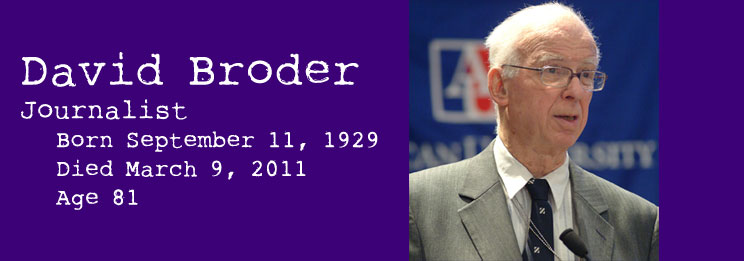 |
||||||||||||||
Brave Last Dave answered the call, and splendidly. * * * In 1976, the Sex Pistols went to Manchester to play a gig. The crowd was tiny; some say fewer than 40 people were in attendance. But legend has it that everyone in attendance started a rock band of their own. The Pistols were a template for something new and exciting. You didn't have to be musicians as skilled as Led Zeppelin or Emerson, Lake and Palmer to create something memorable, but you had to have passion. David Broder compelled people to write in a different way. After reading even one of his columns, hundreds if not thousands of people from all over the political spectrum thought "I am way more interesting than this miserable old fuck!" and decided to become political bloggers. Broder won the Pulitzer in 1973. He celebrated with a double Scotch and a promise to phone it in for the rest of his career. He was called the "dean of the Washington press corps." Some thought this was an honorific, but many knew that it was because he reminded people of Jimmy Dean, who also made bland and barely edible sausage that was bad for you. There are a couple of quotes of Broder's on his Wikipedia page. If you make it to the end of any of them without falling asleep, you either have a much stronger constitution than I do, or you have a serious problem with amphetamines and should seek professional help. If Broder ever had an interesting idea, it died alone and unloved in the middle of an excruciatingly dull sentence. Much like that miserable hack Michael Crichton, the only chance the keyboard would be abandoned by Broder was death. As Brother Theodore reminds us each time we check into this website, "As long as there is death, there is hope!" Some good things happened when Broder died this year. The Washington Post finally had to admit there must be some better use for those column-inches every week, and Morris the Cat and Bushwhacker got all-important points in the race for the Moxie. As of this update, Morris is now residing near the top of the table, while Bushwhacker got that always satisfying first hit of the year. (Actually, the first hit of the last two years.) Five points, plus 3 for the duet. Total: 8. — Brave Last Dave |
||||||||||||||
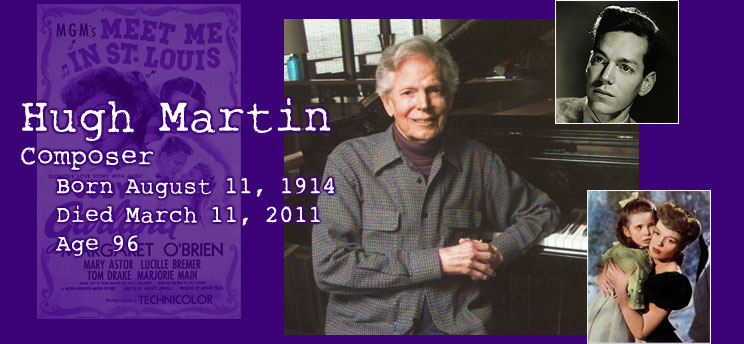 |
||||||||||||||
|
It's really, really hard to write a good Christmas song but, if you manage it, it's money in the bank forever and ever. That's why there are so many bad Christmas songs. Everybody tries, but they usually wind up producing maudlin crap that strings together a series of clichés about food, relatives and snow into three and a half forgettable minutes of seasonal bullshit. The number of truly great Christmas songs written since World War II can probably be counted on the fingers of one hand. "Have Yourself a Merry Little Christmas" is one of them. Hugh Martin wrote it for Meet Me in St. Louis, a 1944 musical starring Judy Garland. Judy thought that Martin's first version of the lyrics was depressing (and she was right), so Hugh pepped up the lyrics for her, as he would again for Frank Sinatra a decade or so later. Despite the changes, it remains the only Christmas song that acknowledges we can't utterly depend on those who are dear to us gathering near to us once more. The years pass; everything ends. When you're fifteen or twenty, you blow that sort of thing off. When you're fifty-five or sixty, not so much. Although Hugh Martin enjoyed a long, solid career in composition and arrangement for stage and film, much of it with his late songwriting partner Ralph Blane, "Have Yourself a Merry Little Christmas" is going to last a lot longer than any of it, or any of us — if the fates allow, of course. Dead People Server gets two points for the hit and five for the solo. Total: 7. — Brad |
||||||||||||||
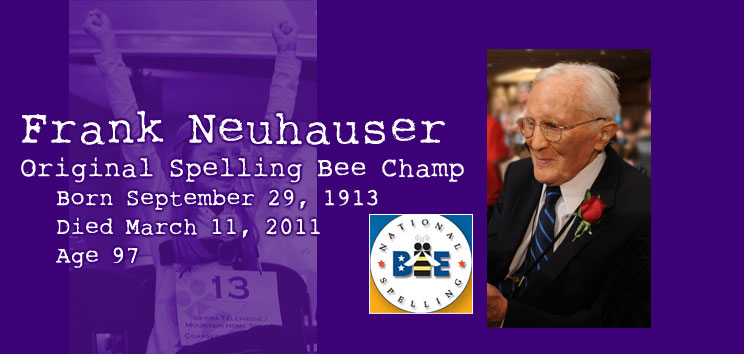 |
||||||||||||||
Another spectacular update from Hulka, whose solo this is ... and it's important that you read it to the very end. * * * By the mid-1920s, the spelling bee — an American tradition dating back to the Pilgrims — was looked upon by many as a hoary relic of a bygone era, as dated as the hoop skirt and the cotton gin. In their 19th-century heyday, organized spelling competitions had been as much a popular diversion as an educational tool, enjoyed by rowdy gold miners [1] and Park Avenue socialites alike, but although some states held competitions among county champions, for the most part these bees remained steadfastly provincial, like the pie-baking and horseshoe-tossing contests they often appeared alongside. Amid the postwar cultural turmoil of the Jazz Age, "the indoor sport of spelling bees, so popular in the days when schoolhouses were painted red," was considered "worth reviving — as an antidote to jazz and frivolity." [2] In that spirit, the Louisville Courier-Journal organized the first National Spelling Bee in Washington, D.C. in 1925. From a field of more than two million schoolchildren, nine contestants spelled for the gold medal and $500 prize; when the final bell rang after 90 action-packed minutes, the first national champion was Louisville's own Frank Neuhauser, 11 years old. His winning word was "gladiolus," a flower he grew in his own garden. As 1986 national champion Jon Pennington said, "There aren't any [National Spelling Bee winners] living under bridges or cracking under the pressure [...] The only thing that tends not to be average about them is they tend to be smart and have very large memories and usually have more degrees than the average person." [3] Frank Neuhauser was no exception; far from peaking early, he earned degrees in engineering and law, and spent a long and fruitful career as a patent lawyer, serving as president of the American Intellectual Property Law Association and chairman of the American Bar Association's patent law division. He also lived to see the tradition he helped inaugurate become a fixture in the American popular imagination — not only prime-time TV entertainment but also fodder for a best-selling novel and an Oscar-nominated documentary. At the end of his life, he was a regular in the audience at the Scripps National Spelling Bee, signing autographs for contestants and cheerily telling reporters how much easier competitive spelling was in his day. — Hulka [1] http://poetry.poetryx.com/poems/11523/
|
||||||||||||||
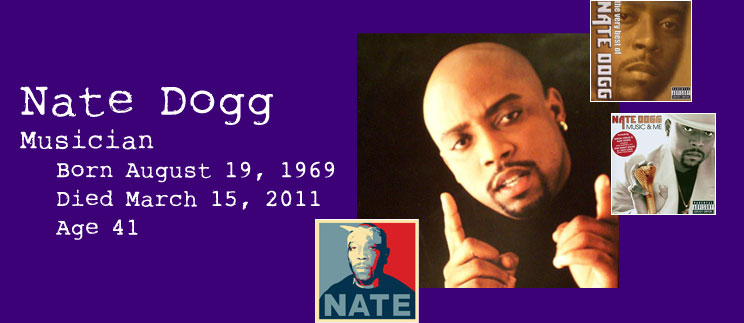 |
||||||||||||||
|
Fireball nailed it. This may be my all-time favorite update. * * * In December 2009, leading up to the 2010 alt.obituaries Deadpool, Amelia asked all of us for assistance with writing obituaries. Just for shits and giggles, I e-mailed Amelia my 2010 list with the statement that, sure, I'll write an obituary if a rapper or Wilford Brimley passes on. I made this request thinking that this would be the easiest job in the world. None of the rappers we want to die actually do. Only the really good rappers, like Tupac and Biggie, die young. And Wilford swam in the pool at the retirement home, so he's never gonna die. I can look like I'm contributing to the obituary process without actually contributing to the obituary process. But when I woke up on March 16 to the news that Nate Dogg had passed away, I woke up to this reality: The free ride is over. Nate Dogg's career can be summed up pretty easily: He was the Billy Joel of rap music. Nobody could sing a hook like him. If you had Nate performing on your track, chances are your track would be a classic. Why, I'll bet you millions to muffins that even one of Billy's great songs could be made even better if it had its chorus done by Nate. Nate was born with the patriotic-sounding name of Nathaniel Hale in Long Beach, California. Not surprisingly, he grew up with the two triple OGs who have defined the LBC: Snoop Dogg and Warren G. (Nate's cousin, Danny Means, also went on to become a well-established rapper by the name of Butch Cassidy.) At age 16, Nate dropped out of high school. Not to join the Crips, but to join the U.S. Marine Corps. After three years in the USMC, he returned to Long Beach to hook up again with Snoop and Warren ... this time, to join the Crips. And to form a rap group called 213 (named after Los Angeles' area code, of course). 213's demo was heard by Warren's cousin, Dr. Dre, and thus began their careers. Nate, Snoop and Warren all made their national debuts on Dre's iconic 1992 album, "The Chronic." (Spoiler alert: It's about some really good weed.) Nate stood out with what would become his trademark voice. "He wasn't the best singer ever," as Brad Wete of Entertainment Weekly stated, "[b]ut boy, Nate was necessary. Every track he blessed with his voice — monotone, melodious, and stern — became so much more intense." But it was in 1994 that Nate would become a household name, thanks to these words:
Those are some of the bars to Warren's rap anthem, "Regulate." This not only became Warren's signature song, it became Warren's biggest hit. It spent three weeks of the summer at #2 on the Billboard Hot 100 (denied the #1 spot by All-4-One's massive hit "I Swear") and received a Grammy nomination, the first of four lifetime nominations for Nate. This song also resurrected the career and financial status of Michael McDonald, whose career was basically in the shitter after that duet with Patti LaBelle in the mid-'80s, as it featured the familiar melody from McDonald's hit "I Keep Forgettin'." Nate recorded a number of songs with Death Row labelmate Tupac Shakur, but his collabos with Snoop, Warren and Dre were the ones that got the airplay and the chart numbers. In 2001, he delivered this hook — probably my all-time favorite Nate Dogg lyrics:
This is from the Top 40 hit "Can't Deny It" by a then-unknown New York rapper named Fabolous. Ten years later, Fabolous is still one of the hottest rappers in the game, and it never would have happened without Nate. Do you think that "Can't Deny It" would have been the hit it was if its hook had been performed by somebody like Nelly or Eminem? No. Not just "no," but "hell no." Fabo's music never would have left the underground rap scene. More likely than not, he would be John Jackson, that guy who has to clean up the dried pools of jizz and kiddie puke from the restrooms of the local Arby's. Another Top 40 hit for Nate in 2001 was his collaboration with Atlanta rapper Ludacris, titled "Area Codes", otherwise known as "A Tribute to President Clinton":
2003 marked the pinnacle of Nate's success on the charts, with these words:
"21 Questions," Nate's collaboration with Fiddy Cent, went all the way to #1 on both the Billboard Hot 100 and the Billboard R&B charts ... Nate's only #1 song on either chart. But the above barely scratches the surface of Nate's resume. He has rapped with just about anybody who is anybody in the rap game: Biggie, Lloyd Banks, David Banner, Joe Budden, Cam'ron, Chingy, Jermaine Dupri, E-40, Eve, Freeway, Game, Ghostface Killah, Cee-Lo Green, Ice Cube, Jadakiss, Jay-Z, Kurupt, Lil' Flip, Li'l Jon, Master P, Memphis Bleek, Mobb Deep, Mos Def, Pharaohe Monch, Raekwon, Redman, Saigon, Twista, Xzibit, Young Jeezy and Shaquille O'Neal. His R&B collaborators include Baby Bash, Mariah Carey, Craig David and Brian McKnight. And yes ... songs by Nelly ("L.A.") and Eminem ("Shake That") have gotten the Nate Dogg treatment, too. Whereas many rappers release one or two albums and then disappear from the face of the earth, Nate gave us some 150 songs during a 17-year-long career. A total of 22 of them made the Billboard Hot 100. Ten of them were Top 40 hits. With all of the great things that I've had to say about Nate, most of you are probably asking me, "If he was such a great rapper, why did you put him on your deadpool list?" Well, he was the exception. He was the only rapper I put on my list because he was physically ill. On December 19, 2007 he had a stroke. On December 20, 2007 he went straight to the top ... of my deadpool list. Just to rub it in my face, the hospital released him after I submitted my list and the doctors stated that he would make a full recovery. The following September, he had a second, more debilitating, stroke. And the vultures started circling. 2009 goes by ... vultures still circling. 2010 goes by ... vultures still circling. On March 15, 2011 the vultures stopped. And so did Nate. The master of G-funk died at age 41 with an impressive career of 22 hits on the Billboard chart. I, however, am still alive at age 30 with a not-so-impressive career of 39 hits on the AODP chart. Nate is not only my 40th career hit, but my biggest hit ever. But, like Nate, I rarely go solo. Eternity Tours and (new to the game) Walking Dead Dude decided that they wanted to ride with a true player, so the three of us get 18 in the clip and 1 in the hole. 19 points total. (Youngest hit of the year so far.) — Fireball |
||||||||||||||
 |
||||||||||||||
|
Michael Gough was one of those wonderful British character actors who made himself at home in any role he played. His lean, menacing look as a younger man led him into mid-century genre films such as Horror of Dracula and Horrors of the Black Museum, but he also did comedies, such as No Place Like Homicide!, in which he played a butler. There was also Konga, in which Gough's mad scientist grows a friendly little monkey into something the size of King Kong, and who then runs around London smashing things. Gough worked steadily in films, TV and on stage in Britain and the U.S. throughout a career of more than 70 years, but he wound up being best known for his role as Alfred Pennyworth, faithful butler and confidant of Bruce Wayne, in the 1989 Batman film and its three sequels. You could be forgiven if you didn't recognize Alfred as Konga's drug supplier, or Doctor Who's nemesis The Toymaker, or as the Master of the Moon in the godawful They Came from Beyond Space. Over the decades, Michael Gough's features had aged and softened, and they had become lined and friendly. As Alfred, Gough finally found himself beloved by audiences. He would play Alfred not only in those four films, but also in a BBC Radio dramatization of the Batman saga Knightfall as well as in TV commercials for Diet Coke and, later, for OnStar, in which ever-helpful Alfred has had the service installed in the Batmobile. By the way, it rhymes with "cough." Born with the Defect (first hit of the year), Happy No Year and Kixco score two points each for the hit, and an additional point for the year's second trio. Total: 3. — Brad |
||||||||||||||
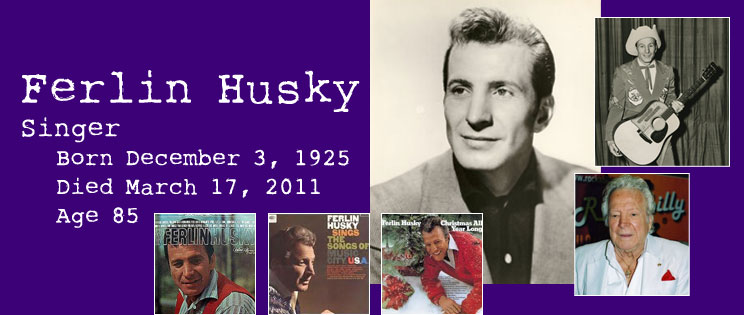 |
||||||||||||||
Busgal gets the hit and gets to write the update. Both fantastic. * * * Since he's "Gone," we remember one of country music's early ambassadors, Ferlin Husky, aka Terry Preston, aka Simon Crum. Ferlin Husky was born in southeastern Missouri, and his entertainment skills were honed as a Merchant Marine, where he entertained troops during WW2. His ship transported troops across the English Channel for D-Day. When Husky came home from the war, he took several jobs, one as a DJ, and he also played gigs from St. Louis to Springfield, Missouri before heading out to California. One gimmick he used was the alter ego Simon Crum, an outspoken hayseed character based on his one-time neighbor Simon Crump. Four Star Records signed him around 1951 and suggested the name Terry Preston. One of his first singles, recorded as Terry Preston, was "Gone," but was recorded without strings or backup singers. By 1953 he had moved to Capitol, where he did the male recitation of "A Dear John Letter" with Jean Shepard. He re-recorded a more countrypolitan version of "Gone" in 1957, and it went to number one on the country charts. In 1960 his biggest selling record, "On the Wings of A Dove," was released. (It was covered by Robert Duvall in Tender Mercies.) With 18 movies to his credit, Ferlin was one of the first country singers to have a star on Hollywood's Walk of Fame. Some of Elvis Presley's first tours were opening for Ferlin, and they were friends to the end of Presley's life. Husky traveled extensively, performing through 2010, when he received the ultimate honor: membership in the Country Music Hall of Fame. — Busgal
|
||||||||||||||
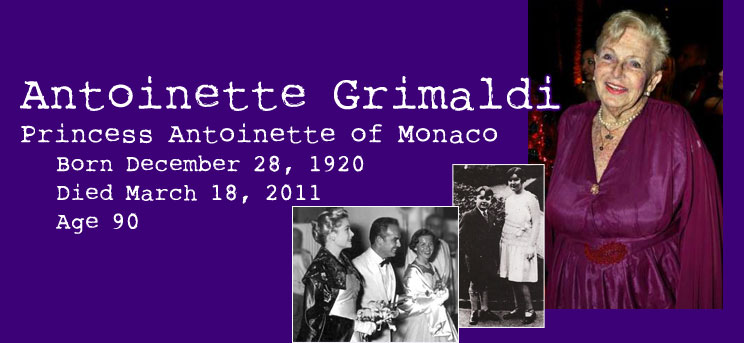 |
||||||||||||||
This crazy bitch was the tip of the crazy iceberg of Monaco. Monaco is a strange place. Its economy is based almost totally on gamblers and tax exiles, people who care very much about the succession to the gilded tin throne of Monaco because, under Monegasque law, if the royal line were to fail, the country would revert to France — and all those tax exiles and gamblers would find themselves facing a hefty French tax bill. Recent changes to the laws have made that possibility remote, but at the time Antoinette of Monaco was born it was a very real threat, which explains a lot about her upbringing. Antoinette's mother Charlotte was indeed born on the wrong side of the blanket to Louis II of Monaco and Marie Juliette Louvet, but Mlle Louvet was no washerwoman: She was a cabaret singer, which at the time was a fine, well-understood euphemism. Monaco being a dictatorship at the time, Louis II could do whatever the hell he wanted except father a legitimate child, so in 1919 he adopted and legitimated Charlotte for lack of a more appropriate heir. (Given that the only other surviving heir to the Monegasque throne at the time was some German blowhard who wasn't even competent enough to hold onto the throne of Lithuania, Louis probably thought he had no other choice.) But then Louis idiotically married Charlotte off to a fabulous French nobleman named Count Pierre de Polignac, who took his wife's name, title, jewels, and money upon marriage. Charlotte had two children, Antoinette and Rainier, and they might even have been her husband's (yeah sure), but eventually the exasperated Louis II threw Pierre out of the country and threatened to call out the mighty Monegasque army if Pierre set foot in the principality again. Louis also had Charlotte "voluntarily" set aside her claim to the crown in favour of her son. The highlight of Antoinette's life was her attempt to oust Rainier from the Monegasque throne in favour of her very young son. She and her lover, the president of the Parlement, intended to rule through the child as regents, but to do so they had to get rid of that annoyingly normal brother of hers. Their cunning plan: destroy the public's support of him by spreading rumours that his girlfriend was sterile. For unknown reasons this did nothing but accelerate the breakdown of Rainier's relationship with the woman in question and propel him into a marriage with the beautiful, imperious and eminently fertile Grace Kelly. Within weeks of the wedding, Antoinette was sent packing and told never to return. She married her president, and later a gay ballet dancer, and later did what neither of her parents could do: She gave up on men. The more stately newspapers called Antoinette a tireless campaigner for animal welfare. That translates to "crazy dog lady." She lived alone, except for 90 dogs, an assortment of cats, a scattering of overworked and exasperated servants, and the odd confused paparazzo. Incidentally, here's a photo of a member of the Monegasque army. You think Pierre really would have minded? — Charlene
|
||||||||||||||
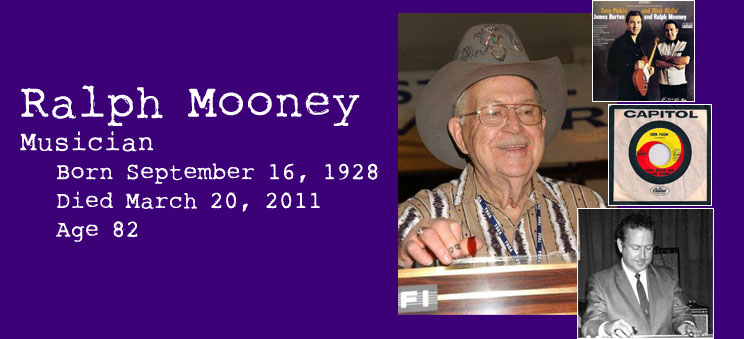 |
||||||||||||||
Another fantastic hit and update from Busgal. She's on a roll. And she's not done yet. * * * |
||||||||||||||
|
||||||||||||||
While his co-writer's royalties kept food on the table, Ralph Mooney was out on the road with Wynn Stewart and doing session work at Capitol Records in Los Angeles, providing his brand of pedal steel guitar to the Bakersfield sound. As a teenager, Ralph used a knife to flat-pick on his guitar after hearing Leon McAuffie on Bob Wills's version of "Steel Guitar Rag." His early pedal steels used coat hangers and a bicycle pedal. (Wanda Jackson asked Ken Nelson, "What is this guy going to do to my session?") Ralph's prominent session work started with Skeets McDonald, then on to Stewart, Wanda Jackson, Buck Owens and Merle Haggard. Most folks will remember his twenty years touring with Waylon Jennings. In recent years, Ralph mostly played steel guitar shows (I saw him several times at the Texas State Guard Association convention in Dallas), and his last recordings were on Marty Stuart's 2010 album Ghost Train. — Busgal
|
||||||||||||||
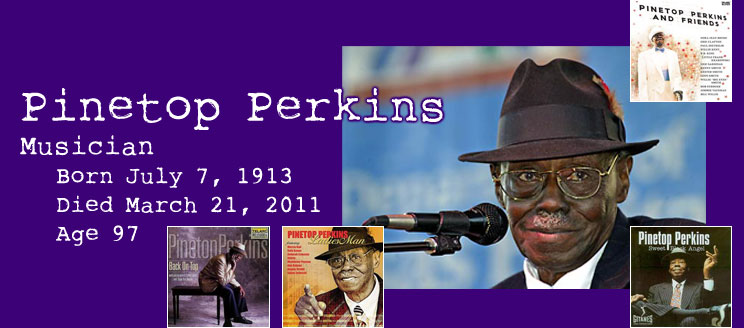 |
||||||||||||||
A Bill Schenley special. * * * He smoked since 1922, and worse ... every day he ate quarter-pound cheeseburgers at the golden arches fast-food place he called McDaniel's [1]. Dressed as an old-time pimp, he was in bars almost every night of his adult life, and he would often play piano, for free, until the early-morning hours — and that was after he turned 70. After his wife died, he drank himself into a stupor until he was 85 years old. At 86 he was still going home, late at night, with women young enough to be his great-granddaughter. Pinetop Perkins has died at 97, and he was a bluesman. At the time of his death, he still had twenty dates he was booked to play. He embodied the Joy of the Blues. Pinetop wasn't a smooth Blues piano player like Otis Spann (whom he replaced in Muddy Waters' band), but he was, as they say, ragged and right. He taught Ike Turner how to play Boogie Woogie style piano, as heard on "Rocket 88" and, as a result, some music historians credit Perkins for helping invent rock 'n' roll. He topped comedian George Burns as the oldest person to win a Grammy. He was a friend to the great Robert Johnson, and he performed with musicians like Muddy Waters, Robert Nighthawk, Earl Hooker, Hubert Sumlin, B.B. King, Ike Turner, Sonny Boy Williamson, Robert Lockwood, Jr., Big Mama Thornton and just about every other bluesman alive during the last eighty years. He was in Martin Scorsese's "The Last Waltz," and he appeared in the movie "The Blues Brothers," pounding the 88s behind John Lee Hooker. Fittingly, Pinetop Perkins was buried in Clarksdale, Mississippi, at McLaurin Memorial Gardens ... on Highway 61. Oh yeah, and one more thing. He was on my deadpool list — for years. But this year I'm singing this tune with Buford. We each get two points for the hit and another three bonus points for the duet. Total: 5. — Bill Schenley [1] Guitarist Elvin Bishop told this story about Perkins: "We were both nominated for a Grammy, so we decided to go together and 'Big Dog' it [take a limo]. On the way to the Staples Center in Los Angeles, Pinetop suddenly screamed at the driver, 'Turn left into the McDaniel's!' The limo driver pulled into McDonald's, and Pinetop ordered his usual two cheeseburgers, an apple pie and a Sprite, on the way to the Grammys." |
||||||||||||||
 |
||||||||||||||
Jim Thornton, our resident AO Deadpool poet, delivers the update and, of course, the poem, which follows. * * * From child star, to collector of husbands and diamonds, Elizabeth Taylor was high maintenance. In 1963 it took a record $1M to persuade her to take her most famous role, Cleopatra. She got husband number five, Richard Burton, but the cost overruns and resulting flop nearly bankrupted 20th Century Fox. Burton found her expensive too. Her engagement ring, featuring the 33-carat Krupp diamond, was followed by gifts of no fewer than three other diamonds big enough to be given a name: the La Peregrina Pearl, the Taj-Mahal and (eventually) the biggest of them all, the £1M, 69-carat Cartier (later Burton-Taylor) diamond. He shouldn't have been surprised; she had form. She'd pulled in a £500,000 divorce settlement from husband No. 1, Hilton heir Conrad Jr. Michael Todd (No. 3), and his best friend Eddie Fisher (No. 4) had also both done their best to keep her happy with big rocks; Fisher later complained that a £50,000 diamond kept her sweet for only about four days. The problem, as Burton saw it, was she had been too famous too young, and a spoiled brat ever since. He had a point. Wholesome good looks and a winning manner had made the child star. As an adult, the looks got less wholesome, and pulled in seven husbands, but she skipped the winning manner, which led to eight divorces. Her performance in Cleopatra was dire, and her illnesses kept costing other people fortunes. When later in life she put on weight and developed back trouble and an alcohol problem, few had much sympathy for her. But that was unfair. Plenty of people drink too much and get fat, and the back troubles allegedly stemmed from a fall during shooting of National Velvet, the film which had made her famous, about a kid who rides the winner of the Grand National. And she wasn't a bad actress. Although her first Oscar, for playing a whore in Butterfield 8, was by common consent won by the sympathy vote — Michael Todd had been killed in a plane crash the previous year — her second, for Who's Afraid of Virginia Woolf?, opposite Burton, was well deserved. In three of her best films (Cat on a Hot Tin Roof, Suddenly Last Summer and Reflections in a Golden Eye) she played women married to men with sexual secrets. Eight marriages to seven men must teach you a bit about male sexuality. She probably learned a bit from the male friends she didn't marry, too. Nearly all were gay. After the death of one of them, Rock Hudson, she supported many gay causes, even selling her diamonds for some. She managed to get her penultimate husband, John Warner, a Virginia politician, not only elected to the U.S. Senate, but to make him one of the most socially liberal Republicans to ever come out of the South. It was no surprise that she stood by her friend Michael Jackson as he faced his child-abuse accusations. Through it all her fame kept growing. Hobnobbing with royalty one day, and picking up husband No. 7, a lorry driver named Larry Fortensky in rehab the next, she rose far beyond normal celebrity. By her death, Andy Warhol's iconic silkscreen prints of her had become as valuable as those of Marilyn Monroe. She outlived all but her last two husbands, and even her New York Times obituarist — but not me, and not you. Abby, Allen Kirshner, Allezblancs, Another Lurker, Brave Last Dave, Brigid, Busgal, Carl & Cherie, Chaptal, Denise, DGH, Direcorbie, Erik, Exuma, Fireball, JD, Jim Thornton, JTH, Kathypig1, King Daevid, Loki, Mo, Roxanne Wiggs, Undertaker and Worm Farmer get 8 points apiece. (First hits of the year for Abby, Another Lurker, Brigid, Denise, DGH, JD, Jim Thornton, JTH, Kathypig1, King Daevid and Worm Farmer.) Here's a poem. |
||||||||||||||
|
||||||||||||||
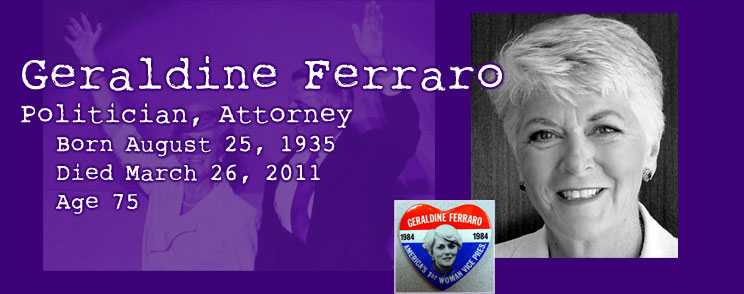 |
||||||||||||||
|
So it's 1993, I'm 40, just turned. Recently been let go, but freelancing. I'm having a bit of a mid-life crisis, with all kinds of health issues. I run into a headhunter at a party and I say, what's to become of me?? I'm 40 and in advertising. And she said, oh Amelia, you have nothing to worry about. There will always be men who want to push women around. She was completely right. To this very minute, nearly 18 years later, I've been one of those women, letting men push me around while I did their work. Geraldine Ferraro, to the best of my knowledge, didn't let any man push her around. She broke into the biggest men's club of them all. Sixty-four years after women got the vote, in the uphillest battle of them all, she ran as VP and did us all proud. After she went to law school at night, taking "a man's place," according to the admissions officer. After she waited until her children were school-age to go to work. After she had worked in a cousin's law office. After she toiled in Congress on unglamorous committees. After being called a bitch by that bitch Barbara Bush. She was a woman to admire. Every woman running for a big office must surely know she blazed the path. I had her on my deadpool list for years, but took her off when I saw her during Obama's campaign telling a little bit of the truth no one on the left wanted to hear. She looked great, I thought. So Morris the Cat gets the solo. 8 points plus 5 for the solo. Total: 13. — Amelia |
||||||||||||||
 |
||||||||||||||
Andrew McKie, one of England's (and Scotland's) finest writers, has done for us what he did for the Telegraph for many years: written a marvelous obituary. Diana Wynne Jones would have loved it. * * * Diana Wynne Jones wrote children's fantasy books which, like those of Alan Garner, Penelope Lively or Joan Aitken, were not taken very seriously by publishers or critics for many years. But they were taken very seriously by her audience: children who often discovered the pleasures of reading through her work. When her small but devoted following grew up, it turned out to be the people who wrote fiction, or wrote about it. Philip Pullman and Neil Gaiman were among the chief public mourners. In recent years, following the success of the Harry Potter books — pale imitations of her Witch Week — which she had almost certainly inspired, Diana enjoyed wider commercial success and, from academics who had grown up with her earlier work, serious critical attention. The scholar Farah Mendlesohn produced a full-length critical study in 2005, and there was a conference devoted to Diana's work in 2009. She was born on August 16, 1934 in north London, the eldest of three daughters. Her parents were progressive schoolteachers (i.e., weirdos) and, even by the norms of that group, remarkably useless parents. Just before the outbreak of war in 1939, Diana was sent to live with her grandparents in Wales and was not reunited with her parents for four months. When her mother tipped up, she complained that the child had acquired a Welsh accent and refused to hug her. The evacuated family went to the Lake District where they shared, with several other families, the house which had once been home to the children upon whom Arthur Ransome based his Swallows and Amazons stories. Ransome ("a small, tubby man with a lot of beard") complained about the noise the children were making; Beatrix Potter smacked Diana's younger sister for swinging on a gate. Diana began making up stories for her younger sisters Isobel [Armstong], now Emeritus Professor of English at Birkbeck College in the University of London, and Ursula, a successful children's author and actress who once played Elsie Duckworth in Coronation Street. Diana had to made up the stories because their father was too mean to buy books for them. In 1943 the family moved to Thaxted in Essex, where her parents ran an educational conference centre while their daughters slept in an unheated lean-to. Diana went from a Quaker school to St. Anne's College, Oxford, where she attended classes with C.S. Lewis ("a superb lecturer") and J.R.R. Tolkein ("almost inaudible"). She discovered children's books while reading to her three sons and began to write when the boys started school. In 1970, shortly after a year in America, where her husband was teaching at Yale, Diana published her first and only novel for adults, Changeover, a satire about the dying days of colonial rule. But she had already concluded that she would have to write fantasy, since she had so little experience of normal life, and for the next four decades concentrated on children's books, sometimes turning out three a year. The first was Wilkins' Tooth (1973). Among the best of the rest are The Ogre Downstairs; Dogsbody; the Chrestomanci books; Archer's Goon; The Time of the Ghost; Fire and Hemlock; The Dalemark Quartet; and Howl's Moving Castle and its sequels. The Tough Guide to Fantasyland is a merciless send up of sub-Tolkein fantasy. In 1976, after her husband took up a post as Professor of English at Bristol University, the couple were involved in a serious car accident. Diana Wynne Jones was often in pain thereafter. Last year, she was diagnosed with cancer, but continued to work. "I get unhappy if I don't write," she said. "Each book is an experiment, an attempt to write the ideal book, the book my children would like, the book I didn't have as a child myself." — Andrew McKie
|
||||||||||||||
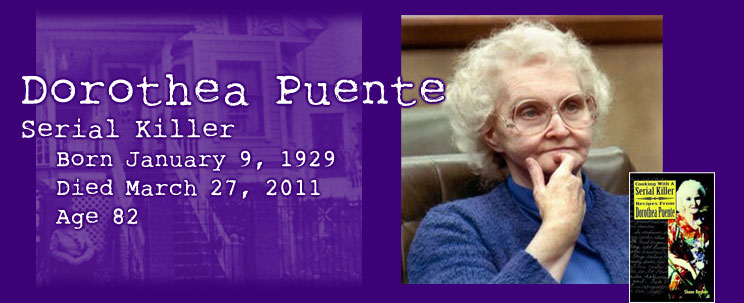 |
||||||||||||||
As serial killers go, four-times-married Dorothea Puente was not the most outrageous, nor did she rack up the biggest body count, nor was she beautiful or Panavision-sized evil or any of those other things that lift a common killer into the limelight of national attention. What she was, was a woman, and women don't tend to be serial killers — or maybe it's just that they're better at hiding the bodies and keeping their mouths shut. Puente was also a landlord, which makes her story even better, because we all know that landlords secretly want to kill and bury their tenants ... or maybe that's just in New York. Anyway, Puente's life of crime began early, with convictions for check forging, vagrancy and being the madam of a brothel. Eventually she became a nurse's aide and, in the late 1960s, began running a big boarding house on F Street in Sacramento, California, where she cared for the disabled and elderly. Puente also sidled up to elderly men in bars and relieved them of their benefit checks, which she forged and cashed. Since her victims were drinking up their benefits, the thefts may not have made much difference, but the cops frown on that sort of thing anyway. Puente was nabbed and got probation. It was then that she turned her life around, by which I mean that she went right back to cruising bars and stealing benefit checks from elderly drunks. The cops said later that, along with whatever she was getting by swatting barflies, Puente was also making as much as five grand a month stealing benefit checks from those under her care at the big boarding house. However, all those murders didn't start until Puente relocated a few blocks up F Street in 1981. Puente's friend and business partner, Ruth Monroe, moved in with her a few months later. Monroe committed suicide with prescription drugs not long after she arrived. Anyway, that's the story Puente told the cops, and the cops believed her. Puente was arrested a few months after that for stealing from one of her tenants at the new house, and she did three years of a five-year sentence. While she was in the clink, Puente struck up a correspondence with Everson Gilmouth, who was 77 and retired. Even if you were 77 and retired, your meat was still plenty fresh enough for Dorothea Puente. Their correspondence soon blossomed into love, and when Puente was released in 1985, Gilmouth picked her up in his 1980 red Ford pickup truck. They lived together in the F Street house and began making wedding plans. That November, Puente hired a handyman to do some work in her apartment. She paid him with a 1980 red Ford pickup truck which, she said, belonged to her boyfriend who had left her and moved to Los Angeles. Puente also asked the handyman to build a box six feet by three feet by two feet for some junk she wanted to put into storage. Sure, said the handyman. He and Puente loaded the now-heavy and tightly nailed box onto that 1980 red Ford pickup truck, and when Puente said forget the storage, let's just toss the box onto that remote building site over there, the ever-agreeable handyman said okay. Sure, somebody found the box within a few months, but the cops didn't identify Gilmouth's badly decomposed body for another three years. Meanwhile, Puente kept accepting tenants at F Street and cashing Gilmouth's benefit checks. According to the conditions of Puente's parole following the short nickel she did for theft, she had to stay away from the elderly, and she wasn't allowed to handle government checks. In fact, parole agents told Puente more than a dozen times to stop doing what she was doing. Ha ha! A fine joke! By the end of 1988, even the cops in Sacramento began to suspect that something was up at F Street. They dropped by to look around a bit. Puente said fine, I'm going out for coffee and I'll be right back. The cops said okay. Puente instantly fled to Los Angeles and quickly made friends with yet another elderly pensioner, but this one wasn't quite as braindead as the others, and recognized Puente from her many pictures in the paper. He turned her in. The cops found seven bodies buried in Puente's backyard. Puente wound up being charged with nine murders, but she was convicted of only three. One of Puente's defenses was that everybody had died of natural causes, and that she'd buried the bodies in her backyard because she didn't want anyone to know she was violating her parole by taking in elderly tenants. (She'd kept right on cashing their benefit checks, though.) The trial lasted a year and the jury deliberated for more than a month, and it deadlocked on six of the murder charges. It also deadlocked on whether to give Puente the death penalty, so she got life without parole, which is the sentence she recently completed serving. While Puente was in prison, one of her correspondents put together a few dozen of Puente's home-cooking recipes — the barbiturate-free ones, I hope — along with some other material, and it was all published in 2004 as a book called Cooking with a Serial Killer. M'mm m'mm good! DDT and Loki get five tasty points for the hit and an extra three for the duet. Total: 8. — Brad |
||||||||||||||
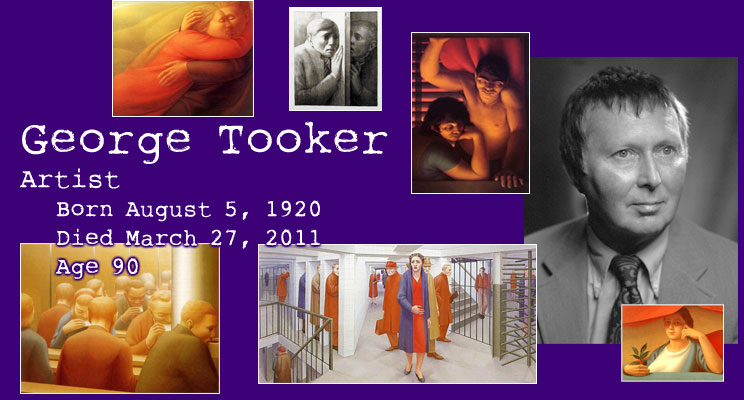 |
||||||||||||||
The painting is in the permanent collection of the Whitney Museum of American Art. You can usually see it on the top floor with all the amazing Hoppers, Bellows, O'Keeffes, Sheelers and Marshes. And yet, I'd wager not a soul reading this had heard of George Tooker before his death recently at the age of 90. The painting is called "The Subway," it was painted in 1950, and I go to see it every chance I get. Tooker did a lot with anxiety. He painted waiting rooms and government offices and subway platforms, where people are (of course) waiting or lost or just staring into the eye of the beholder, screaming silently. It was the mid-century equivalent of "your call is important to us, so listen to this mind-numbing music until we give you a thorough run-around." Harried people entering the world of the underground and bureaucracy through turnstiles and frosted glass. It's said that you can't look quickly at a Tooker painting and turn away. It's possible that he wasn't more well-known outside of art historian circles because he was gay, but I think it's more likely that it's because he left New York for Europe and, when his lover died, found religion and Vermont. Also, he was painting these angst-ridden figures just when abstraction was the hot thing. By his own admission, he painted happier pictures as he got older and got fewer complaints. The first time I saw "The Subway," I was surprised to see the artist was still alive. Taking advantage of that insider information, I enter the pool for 2011 with 2 points for the hit and 5 for the solo. Total: 7. — Amelia |
||||||||||||||
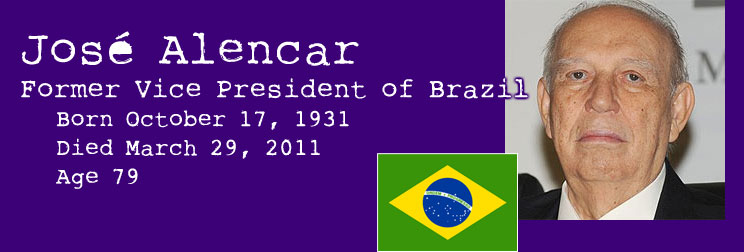 |
||||||||||||||
|
I adore Jim Thornton from Nottingham. I ask him to do the hard ones, he does them with gusto and adds a fantastic poem. Enjoy! * * * José Alencar Gomes da Silva In 2002 it was election time in Brazil, and Luiz Inácio "Lula" da Silva, a left-wing union firebrand, looked like he might win. The poor dreamed of land reform and communism, the rich had nightmares about the same things, and the outside world looked on anxiously. Leftist movements generally end in tears in South America. Would this be the next Chile or Venezuela? But Lula took a businessman, José Alencar Gomes da Silva, as his running mate, reassuring the middle classes, and the pair of them won two elections before peacefully handing over power in a free and fair one last year. Lula is now feted everywhere as the architect of Brazil's steady growth, reduced debt, increased employment and social liberalisation, but he owed much of his success to Alencar. Alencar, like Lula, was born in rural poverty, and created his company Coteminas (a huge textile and clothing conglomerate) from nothing. By all accounts he was a good boss. He made a fortune and spent it running for election. His first attempt was unsuccessful, but in 1998 he got in as a senator for the centre-right Liberal Party, and turned out to be a skilled and popular politician — so popular, in fact, that Lula invited him to balance the ticket. Alencar didn't need asking twice. He deserted the Liberals for Lula's Workers Party, and together they led two almost miraculously successful governments. Alencar's role was to keep Lula economically sane, the middle classes onside, and troubleshoot whenever one of his colleagues imploded. During one crisis, and over his protestations that he knew nothing about the military, Lula made him defence minister. He made a decent fist of the job for two years before a reliable replacement could be found. Although his health and love life caused trouble from the start, he made them both an electoral asset. In 1997 he underwent his first operation for a slow-growing (albeit eventually fatal) abdominal sarcoma. Over the next 14 years, with 16 further operations (as well as trips to the US for experimental chemotherapy), the public took him to their hearts, not just for the brave fight but for paying the doctors' bills himself! Apparently most Brazilian politicians stick 'em to the taxpayer. During his 2002 campaign, a woman called Rosemary de Morais popped up, claiming to be the unacknowledged love child of Alencar and a nurse named Tita. She produced a fair bit of evidence that he had been Tita's lover in 1954, the year Rosemary was born, but he denied paternity, ungallantly claiming that Tita must have been bonking someone else. The lawyers had a field day, but in South America it does no harm to get into a bit of that sort of trouble, and Alencar managed to float serenely above the scandal. The case rumbled on until July 2010 when a judge ruled that Rosemary was Alencar's daughter, on the basis that refusing to give a DNA sample proved his guilt. His lawyers were just rolling up their sleeves to appeal when Alencar inconveniently died. We can only speculate whether the decision to cremate him quickly was a final effort to keep his DNA out of Rosemary's hands. Deceased Hose, EdV and Gerard Tierney get 8 points for the hit and 1 for the trio. Total: 9. (Editor's note: Have we ever had a 9-point hit? I don't think so.) Here's Alencar's poem: |
||||||||||||||
|
||||||||||||||
 |
||||||||||||||
|
From Busgal, of course! * * * It was in the fall of 1980 when I started listening to country music on WIYQ, Johnstown, PA. Between dating and accounting assignments, I was enjoying some great male vocalists, including the first hits of George Strait. However, one of the up-tempo singers I really enjoyed was a heavy-set guy with long blond hair and one of the worst three cowboy hats in country music [1]. His name was Mel McDaniel. For McDaniel, Nashville success took a couple of tries, but in 1981 he finally scored a hit with "Louisiana Saturday Night." Three years later, he reached number one on the country charts with "Baby's Got Her Blue Jeans On." I got to see him twice, and once at the Grand Ole Opry. He seemed thrilled to be on stage, and it was a joy to see and hear him perform. He's been poolside for me since an induced coma following heart problems in 2009. Mel McDaniel died from lung cancer at age 68, and I get 11 points for the hit and 5 for the solo. Total: 16. — Busgal [1] David Allan Coe and Toby Keith are the other two. |
||||||||||||||
